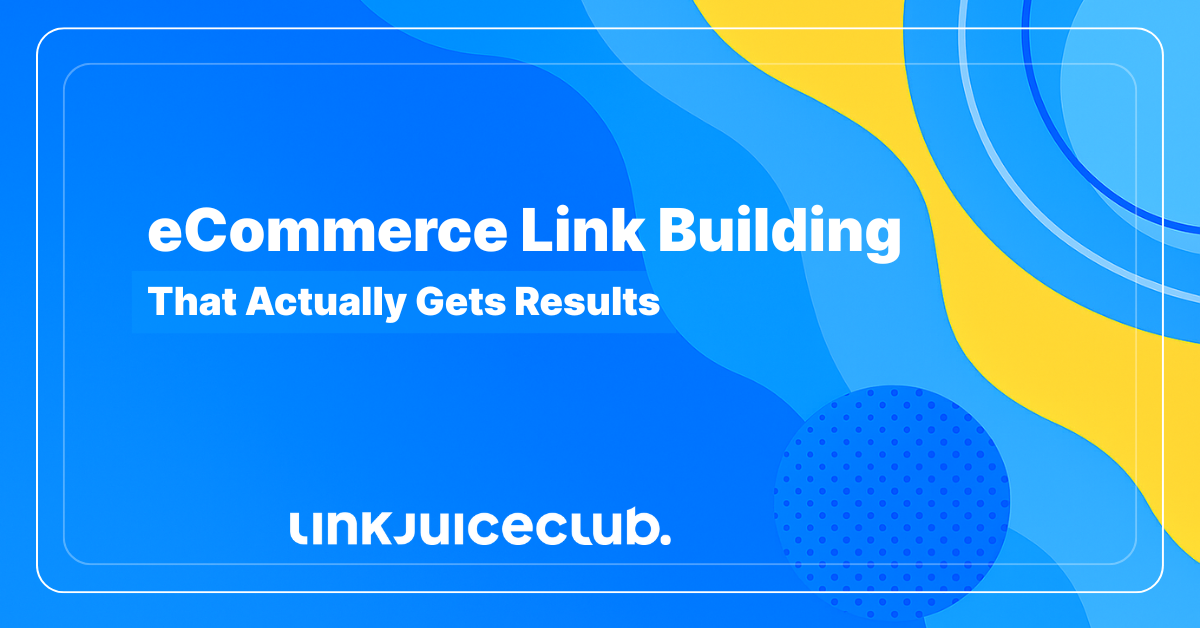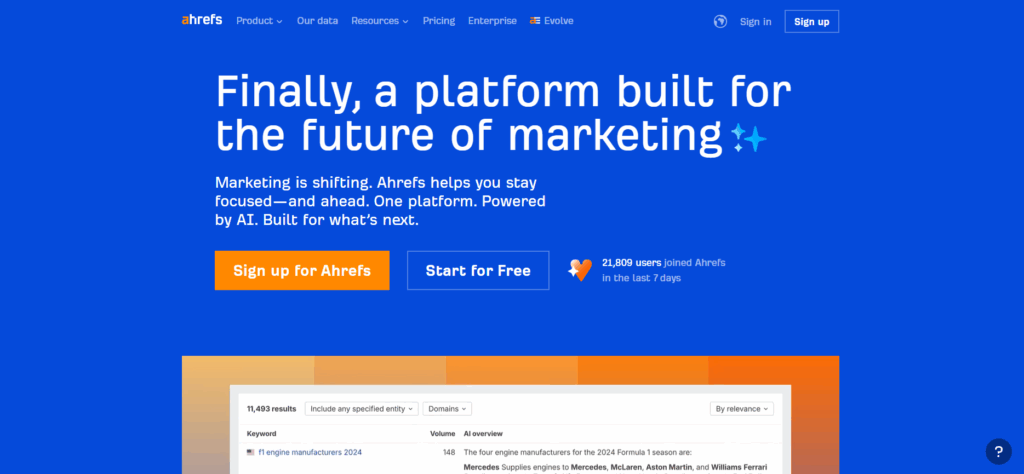
eCommerce Link Building That Actually Gets Results
Whether you run the site, manage clients, freelance, or step in where needed, building links that actually move the needle in eCommerce takes real effort.
You’re up against giants with deep backlink profiles and endless visibility. Every high-value keyword is stacked with global retailers and a flood of near-identical stores selling lookalike products with different names slapped on.
Most people are still out there chasing low-tier blogs for mentions on useless pages and they burn time and effort chasing links that do nothing.
You don’t have that luxury. Your links need to drive rankings, pull in buyers, and create momentum that stacks over time. That takes precision. That takes a real system.
This isn’t about publishing random content and hoping someone bites. It’s about targeting with intent, pitching with purpose, and earning placements that move the needle.
What follows is built for operators who expect results. No empty tactics. No filler. Just straight-up strategies that turn link equity into actual growth. Let’s get started.

What Makes eCommerce Link Building Strategies a Grind (And Why That’s a Win)
Here’s what rarely gets said out loud: most products are dull, site owners aren’t running charities, and no one wants random outreach clogging their inbox
Product pages push conversion, not education, and no shopper is googling “Klarstein AeroVital Cube Mini 1200W Oil-Free Fryer with Touch Control and 4L Basket” out of curiosity
That doesn’t mean your PDPs get a free pass. Optimize them all day long, just don’t expect links to roll in
Nobody’s linking “organically” to a results page showing “matte grey shower caddies,” even though that’s exactly what needs to rank
A lot of content from eCommerce brands barely touches the niche or worse, comes straight from auto-fed news blurbs that add zero actual SEO weight
But… if you can make it work, you get leverage that others might not. Get a paid article published on the right site, and you’re not just building links. You’re buying trust, traffic, and relevance in one move.
Google still leans on links to judge credibility, and that weight moves the needle more than anything else in the system.
Google still leans on links to judge credibility, and that weight moves the needle more than anything else in the system
Make no mistake, this is a grind, but that can give you an edge. Most people stall, lose focus, or never connect the full strategic picture.
Build Before You Beg: Your SEO Foundation Comes First
You wouldn’t build a house on sand. So why launch a link campaign on a site with no structure?
Before you pitch a single email or chase that shady “DR70 for €20” deal, do the one thing most skip:
Step 1: Know Where the Links Should Go
Not every page deserves a backlink. The goal is to place links on pages that drive relevance and value.
Consider this:
- Which URLs should actually rank?
- Are any of them already getting links?
- Do they lead to conversions or dead ends?
💣 Pro Tip
Start with pages that show signs of life: traffic, rankings, conversions. Build where it counts.
Where Should the Link Juice Flow?
Focus your firepower on:
- 📂 Category Pages bring in revenue
- 📘 Guides and Resources act as natural magnets for backlinks
- 🤝 Comparison Content works well for affiliate-focused strategies
- 🧬 About or Brand Pages create strong opportunities for media coverage and trust-building
🚫 Common Mistake
Spraying links across your site without strategy weakens your whole domain. Focus brings returns. Pick your winners and double down.
✅ Step Confirmation
Before you build links, choose your targets. Before outreach, know exactly where the authority should land.
Fix the Flow Inside Before You Look Outward
Before you ask the web for backlinks, make sure your own site isn’t leaking authority like a cracked pipe.
Start with your internal structure, because that’s what tells Google what is relevant. If that’s messy, no amount of external links will fix it.
Ask yourself:
- Are your most valuable pages completely disconnected?
- Are you forcing keywords into every anchor like you’re stuffing a suitcase?
- Are broken URLs still getting links from other parts of your site?
🚫 Common Mistake
Building links to a weak internal structure is like pouring water into a bucket with holes. You waste effort and get nothing back.
What Should You Use?
Here’s the combo that gets results:
- 🧱 Sitebulb or Screaming Frog to map out every internal link and spot errors
- 🔎 Ahrefs to review anchor usage and link depth
- 🧩 Search Console to catch the pages that aren’t pulling their weight

💣 Pro Tip
Every strong external campaign starts with an internal system that’s clean, logical, and intentional.
✅ Step Confirmation
Audit, update, and connect. Your internal network should guide both users and crawlers exactly where you want them to go.
Does Google Know Who You Are?
Here’s where most online stores trip before they even start. They send outreach without earning the right to be visible.
When your brand is recognized as a defined entity by Google, your links carry more strength. You can’t rank what doesn’t register.
Being “real” isn’t about having a logo or a phone number on your footer. It’s about becoming a searchable, structured presence across the platforms Google watches.
Where Should Your Brand Live?
If you want to be treated like a real entity, show up where Google expects real entities to live. Build a recognizable presence across platforms that contribute to trust signals.
- 🌍 Core Listings: Google Business, Trustpilot, Quora, Reddit
- 📲 Social Platforms: Facebook, LinkedIn, Pinterest, Instagram, X
- 🚀 Startup + Tech Networks: AngelList, Product Hunt, Crunchbase (if aligned with your niche)
- 🧠 Profile Builders: Medium, Slideshare, Gravatar, YouTube, About.me, and other authority-rich sources
🚫 Common Mistake
Random mentions on disconnected platforms don’t build trust. Structure and consistency matter more than volume.
💣 Pro Tip
Connect your profiles in a loop by linking between them through bios, footers, or About pages. That loop is your entity stack.
How to Power Up the Signal
- 📌 Use the same brand name, description, and logo across all platforms
- 🌐 Always link back to your homepage or category page
- 🧾Add structured data directly to your website using Schema markup:
- Organization, LocalBusiness, Product, Breadcrumb
- Organization, LocalBusiness, Product, Breadcrumb
- 🧠 Interlink profiles and feature the strongest ones directly within your website
- 🎯 Keep everything aligned in voice, visuals, and metadata
✅ Step Confirmation
Once this system is in place, every backlink passes stronger trust. Your content indexes faster and your site avoids scrutiny. Remember, authority grows quietly, but decisively.
The Selection of Links That Build Authority and Rankings
The rule of thumb is that link quality always outweighs link quantity. A focused DR40 blog in health and wellness delivers more value to your fitness store than a DR90 travel site with zero topical connection. In this game, relevance overpowers raw authority.
Here’s the golden question to ask before chasing any backlink:
“Does this link deliver SEO value, topical trust, and genuine relevance to a revenue-focused page in a way that feels natural and aligned?”
If you can’t answer yes, walk away. You’re not chasing vanity links or padding a marketing report.
Before you even think about outreach, zoom in on what you’re promoting. And no, not all pages are created equal.
What Are You Actually Promoting?
Not every page deserves a backlink. Prioritize by purpose:
- 🧭 Category Pages
These are your revenue drivers with strong ranking potential
Example: /collections/high-protein-snacks - 📘 Supporting Content
Think educational hubs, comparison pieces, and evergreen guides
Example: “The Complete Guide to Choosing the Best Supplements for Your Fitness Goals” - 🧬 Brand + PR Pages
Use your “About,” CSR, or innovation pages. These work well for digital PR and trust-building - 📦 Product Pages
Target evergreen, link-worthy product listings. Skip anything seasonal or likely to disappear
💣 Pro Tip
Send backlinks to your best content, then guide the authority through internal links to high-value pages. That flow creates real ranking power.
How Do You Know a Link Is Worth It?
Every link demands effort, resources, or creative output. Make sure each one earns its keep.
✅ Step Confirmation
Before pitching or accepting a placement, verify the essentials:
- 🔍 Topical Alignment
- The link’s content and readers should match your product’s world
- The link’s content and readers should match your product’s world
- 📈 Traffic That’s Alive
- Check with tools like Similarweb or Ahrefs. A high DR without visits means nothing
- Check with tools like Similarweb or Ahrefs. A high DR without visits means nothing
- 🔎 Index Status
- If the post doesn’t appear in Google, your link won’t either
- If the post doesn’t appear in Google, your link won’t either
- 🔗 Link Type and Placement
- Look for dofollow links placed naturally within relevant content
- Look for dofollow links placed naturally within relevant content
- 📤 Outbound Link Quality
- If the site links to dozens of unrelated brands, treat it as a red flag and steer clear
🚫 Common Mistake
Grabbing links just because they’re “high DR” misses the point. You need strategic placements, not digital clutter.
✅ Step Confirmation
Stack links to pages that matter. Choose sites that pass equity. Audit every pitch like your rankings depend on it because they do.
Know Your Targets Before You Pitch
Not every website deserves your pitch, your content, or your budget. Vet every potential site like a hawk before investing a second of time.
Here’s how to filter the winners from the trash:
Topical Fit: Does their audience overlap with yours even a little? If not, it’s a hard pass.
Real Traffic: High DR is meaningless if the site gets zero visitors. Use tools like Similarweb or Ahrefs to check for actual traffic.
Index Check: If the blog post they’re offering to drop your link into doesn’t show up on Google, you’re throwing money away.
Link Placement: Look for dofollow links placed naturally within relevant writing that actually matches the topic.
Outbound Link Audit : If a post is handing out links to 20 brands, you’re looking at a low-trust setup.
Link Building Tactics That Don’t Waste Your Time (Or Budget)
This is about building links that move rankings and create authority worth measuring. Case studies don’t rank pages, strategy does.
You can get mentioned on some lifestyle blog about Icelandic hiking trails, but that doesn’t mean it helps you sell compression sleeves or smart blenders. Authority without relevance is noise that keeps traffic flat and conversion charts asleep.
Instead of dumping backlinks on low-intent fluff, point them to content that can actually move traffic. Position your links where they make an impact, then channel that authority through your internal structure.
Praise Them Publicly, Watch the Links Roll In
People crave attention. Stroke the ego, and they’ll signal boost your brand without you even asking twice.
Put together roundup-style posts that shine a light on influencers, tools, or creators tied to your niche. Make the praise sound real, not recycled fluff.
Try titles like:
- “9 Brands Reinventing Daily Wellness Products”
- “6 Shipping Tools That Outperform the Market Leaders”
- “Top 5 Creators Every Clean Beauty Label Should Know”
Once the post is live, reach out. DM them. Tag them. Mention it without sounding desperate.
The reaction pattern’s predictable:
- Some will drop you a backlink
- Others repost it to their audience
- A few kick off bigger collabs without needing a sales pitch
Want speed? Use ChatGPT to pull names, write blurbs, and auto-fill the whole structure with formulas in Sheets. You’ll get outreach-ready content without wasting a full week building lists manually.
Guest Posts That Actually Do Something
You can still get results with guest posting, just not the way most people do it.
Start by qualifying the site. Look at real traffic, relevance to your niche, and content quality that reflects an actual audience. Metrics are fine, but engagement signals tell the truth.
Skip the mass outreach. Hunt for the sites that speak directly to your customer base. Prioritize connection over convenience.
Here’s how to make it matter:
- Write content that blends naturally into their site, such as: tutorials, breakdowns, or industry rants that don’t sound like copy
- Slip links into the flow, pointing back to your category or collection pages through smart internal paths
- Stick to blogs with actual audience activity, not hollow metrics
When you pitch, use hooks that reflect real insight:
- “How We Took Orders from 17 to 1,200 Using Zero Ad Spend”
- “Why This Industry Needed Fixing, and What Changed When We Took Over”
- “Tools That Get Results for [Audience] Without the Noise”
If you’re deep in the business, use your own voice. If you’re not, talk to someone who is. One hour with someone who’s in the trenches beats hours pretending to know what they deal with.
Good guest content doesn’t just link. It builds credibility while quietly stacking your SEO foundation where it counts.
Use Competitor Links to Your Advantage
You don’t need to reinvent the whole thing. If another company already has links pointing to their store, that tells you someone saw enough value to send traffic their way.
That means there’s a way in, you just need to find it and offer something better.
It’s not stealing if the intent is to improve what’s already out there, it’s strategic substitution. You’re stepping in with something more relevant, more current, and more useful to their readers.
Start by using a tool called Ahrefs. It shows you exactly who’s linking to which sites, and from where.
Begin with applying these filters:
- Dofollow links only
- Domain Rating 40 or higher
- Only one link per site
- Links placed inside actual content (skip anything in navigation, footers, or sidebars)
📸 Place the screenshot here.
Once you have the list, don’t just stare at it. Ask: why did they link to that site?
- Was it part of a top-10 list?
- Did they review the product?
- Was it a blog post or guide with examples?
This follows the skyscraper playbook, reworked to serve pages that actually drive sales.
Build something that fits the same spot, but make it sharper, clearer, and easier to trust.
Then you send it over and offer it as a cleaner replacement or a more current reference.
This approach saves time. It skips guesswork. And it gives you an edge without having to outspend anyone.
Others already did the heavy lifting. Your move is to take what works, do it better, and redirect the outcome to your own business. That’s how you stay ahead. Quietly, effectively, and without wasting effort.
Ask Brands You Carry for a Link Placement
You don’t have to build everything from scratch to get strong links. If you’re selling someone else’s products, that’s already a foot in the door.
Plenty of brands have a page on their site where they list trusted retailers or partners. You’ve likely seen them: “Find a Retailer” or “Authorized Sellers.”
Reach out and let them know you carry their product. Propose your store as a stockist for that page.
That one message can get you a high-quality link from a site with real authority. No content, no favors, just a simple, professional request.
These links work because they make sense. You’re a verified seller and they benefit by showing people where to find their stuff.
A lot of store owners overlook this. You won’t. You’ll take what’s already available and turn it into an edge. That’s smart SEO: clean, simple, and reliable.
Get Your Brand Listed on Voucher Sites That Actually Matter
Some discount sites help position your brand where shoppers and search engines both pay attention.
If you’re offering a code, make sure it lands somewhere with value. You’re not looking for every coupon site on the internet, just the ones that pull real visibility.
Try platforms like:
- DealDrip
- OfferNest
- CartSlice
- PromoCircuit
- Or a smaller one that focuses on your vertical, like GroomingTags or EcoBuys
Before you submit anything, check if the page is indexable. That’s how you know Google sees it.
Even if the link doesn’t pass equity directly, it can send users, reinforce your brand name, and support your entity footprint.
People browse these sites when they’re ready to buy. Being there at the right time stacks the odds in your favor.
Turn Brand Mentions Into Links (No Tricks Needed)
People will name-drop your brand and leave out the link. Others will add one, then pull the page without warning. It happens more often than you’d expect.
You can track it using:
- Ahrefs Alerts
- BrandSignal.io
- Google Alerts
Once a mention pops up, send a message. It works because you’re following up on something they already did.
Keep it simple:
“Thanks for including us, could you add a link so readers can head directly to the product?”
No pitch decks, no overexplaining. Just a practical request that saves them time and helps their readers.
Local Link Building Still Works (Even If It Feels Old School)
Might be too boring for the cool kids, hence why it’s underrated. Try this instead:
- 💸 Throw some cash at a nearby gathering or industry group. Small budgets go further than you’d think
- 🏆 Offer a grant or prize tied to your niche. No need for balloons, just a form and a blurb
- 🎁 Send products to nonprofits that line up with what you sell. Think more relevance, less photo op
This works because .orgs, .edus, and local media link with weight, and those links don’t come from empty gestures.
Affiliate Links That Stack Themselves
Plenty of store owners still picture affiliates like it’s the 2010s – shady landing pages and spammy banners. That’s outdated thinking.
Here’s what actually happens:
An affiliate signs up and wants to push your product because they need clicks to earn. So what do they do? They send traffic straight to your site.
That gives you:
- Blog articles linking directly inside the copy
- Video reviews that plug your link in the details section
- How-to guides pointing straight to your best categories
- Comparison pieces that just happen to end with your product winning
The best part about it is you don’t pay until they deliver results. They’re adding backlinks because they want traffic. You benefit from every mention and placement they publish.
Now picture this at scale.
Build a simple onboarding process with:
- A step-by-step guide that includes link text ideas and content templates
- Visuals like product mockups or ad banners they can drop into posts
- Landing pages that already convert, so they’re motivated to keep linking
💡 Want to really push it? Offer a little extra to those pushing SEO content. That small bump brings in solid links from blogs built to rank long-term.
And here’s the quiet win: that one article from a small niche site could pull search traffic for years. Every click, every backlink, every lift in authority – all pointing to you.
Do this right and your affiliate crew ends up writing content, building links, and spreading your brand across the internet. No salary required. Just structure, strategy, and a little incentive.
Growing Your Outreach Engine Without Wasting Time or Credibility
You want this to work at scale? Then treat it like a real system, not a late-night outreach binge. Volume’s fine, but sloppiness isn’t. Get the bones right first, then let your tools carry the weight.
Prospecting Smarter, Not Harder
There’s no need to dig for every opportunity by hand. Let the right tools handle the grunt work so your energy goes toward qualified prospects.
- Use Ahrefs alongside Google Sheets and GPT to pull competitor link data
- Organize prospects by niche and keyword relevance
- Sort them by intent: authoritative media, active blogs, or easy wins from user-generated sites
That gives you a focused list that’s worth your time and actually reachable.
Write Templates That Don’t Feel Like Templates
The second your email sounds copied and pasted, it’s over. Good outreach feels human, moves quickly, and offers value without dragging.
- Open with something that shows you’ve seen their work
- Follow with one clear offer or suggestion
- Keep it brief and easy to read
Short, sharp messages win. Nobody’s scrolling through a novel from a stranger.
Log It or Lose It
Use something simple like Notion or Airtable. Track:
- The site you’re targeting
- Their authority score (keep it real, not inflated)
- Who you’re speaking to
- What page you’re aiming for
- What stage you’re in
- What actually happened
Set the system once, and you won’t have to chase your own tail later.
Wrap-Up: Where Google’s Headed and How to Stay Ahead Without Losing Your Shirt
Google hasn’t eased up, it’s just become more selective.
Every core update now leans harder into credibility, context, and proof you’re legit. So tossing up shady backlinks like it’s 2012 won’t cut it. The game now rewards clarity, alignment, and link strategy with a brain.
If you’re still spinning your wheels with the same “tricks” folks used a decade ago, you’re basically daring Google to knock you flat next update.
What actually works right now?
– Clean internal structure and real site authority
– Links aimed at the pages that move revenue
– Scalable tactics with compounding value
– Ruthless tracking so you know what’s landing
Most store owners are still fumbling with templates they copied from a forum in 2019. They chase Domain Rating like it’s currency and wonder why they’re buried under 400 backlinks that lead nowhere.
But you don’t have to worry about that anymore because you’ve got a real plan.
You just need to get your technical house in order. Fix your site so it’s worth linking to in the first place.
Point links to the pages that matter – product hubs, evergreen articles, and the real drivers of revenue.
Use tactics that build over time – affiliate armies, smart link roundups, competitor reclaiming, and content that attracts without chasing.
Keep tabs on what lands, tighten what’s sloppy, and scale what performs.
Because the shops that treat ecommerce link building as a serious growth lever, instead of a shortcut, end up ranking first, moving more products, and holding the lead.
If you want rankings to rise, you need links that carry weight. Grab a snack or get to work because those link juices won’t flow by themselves. Another thing that you can do is reach out to Link Juice Club, since we are your go-to destination for high-quality eCommerce link building!





